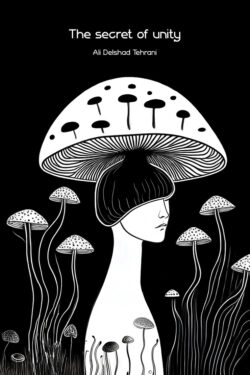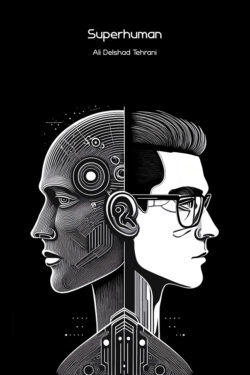Mental Reality Ali Delshad Tehrani
Exploring the Boundaries of the Brain, Mind, and Meaning
Preface: The Inner Construct
Can one ask what reality is without first questioning what makes such a question possible in the first place? Every inquiry into reality rests upon a foundation that usually remains unseen—a background that determines what can be experienced as real at all. Neurophilosophy begins precisely here: with the questioning of the questioner, and with curiosity turned inward upon itself.
If we could see the world through the perceptual lens of a bat, an ant, or a whale, what we call “reality” today would appear in an entirely different form. This difference arises not merely from biological structure or sensory limitation, but from the very angle through which experience takes shape. The image formed in the mind is not simply the outcome of light striking the retina; it is the result of complex processes unfolding within a multilayered context I call the mental pre-context.
The title Mental Reality is not a linguistic coincidence or stylistic whim. It reflects the conceptual direction of this work. The word “subjective” in Western philosophy immediately evokes the classical subject–object duality, dragging the reader back into centuries of debate over relativity, objectivity, and truth. Yet the intention here is not to reenter those disputes, but to construct a new framework for understanding human experience.
Thus, Mental Reality is not a substitute for Subjective Reality, but a shift in perspective—one that releases the reader from classical dichotomies and situates experience not in opposition to objectivity but within the dynamic field of mental pre-contexts.
In this framework, the mind is presented neither as an organ of the body nor merely as the product of neural activity, but as a dynamic ground for the emergence of experience itself. What arises within this ground—sounds, images, thoughts, emotions, pain, and meaning—constitutes the content of the mind. Some of this content originates from the external world, such as the sound of a car or the light reaching the eyes, while other elements emerge from within the mental pre-contexts themselves: an anxiety without external cause, or a memory suddenly resurfacing.
To clarify the concept of mental pre-contexts, imagine writing with a black pen on a blank white sheet. Now replace that sheet with grid-lined paper: the ink and handwriting remain the same, yet the structure, alignment, and even legibility of the text change. The lines on the paper, like mental pre-contexts, provide a hidden structure that shapes how the content appears.
A mental pre-context refers to the entire set of conditions that shape perception and the processing of experience—from genetics and temperament to language, culture, values, beliefs, and lived experience. These structures are not necessarily conscious; many operate as invisible backgrounds that determine what we notice, how we interpret, and what we care about. The difference between two people’s reactions to the same sentence, smell, or scene lies precisely in the difference between their mental pre-contexts.
The human brain constantly predicts in order to guide behavior. These predictions cannot occur in a vacuum—they require context. Mental pre-context functions as the hidden map through which the brain interprets, judges, and responds.
Pre-contexts are not single-layered; they form a multidimensional, nested matrix. Just as one can change not only the lines but also the color of the background paper, mental pre-contexts vary across layers such as mood, native language, childhood memories, hormonal states, and social experience. Every new experience lands upon this background and acquires its meaning within it.
From this view, the mental space can be seen as a dynamic environment in constant flux. Every act of learning, every new experience, every stimulus reshapes it. The mind is not a passive receiver of content; it is an active organizer that arranges, interprets, and even creates experience through its mental pre-contexts.
Imagine looking through a camera viewfinder that overlays information such as exposure, focal distance, or gridlines on the scene. These details are not part of the landscape itself; they appear only because the image is viewed through that particular device.
The same principle applies in augmented reality, where the camera’s image of the external world is overlaid with digital data. What is seen is no longer the world alone but a world interpreted, annotated, and enhanced.
The human mind operates in a similar way. What we call the “external world” is never received in raw form. It is processed through layers of interpretation, memory, language, mental pre-contexts, bodily states, and cognitive models, becoming what we call “experience.”
In this sense, the mind continuously projects an augmented reality—not with digital data, but with lived pasts, values, culture, language, and even momentary bodily states. What we see, hear, or feel is the encounter between sensory input and the intricate field of pre-contexts. The world is therefore interpreted within us, not merely perceived.
These invisible filters not only shape our understanding of the world but also define what is even “seeable,” “hearable,” or “feelable.” Just as a colored lens transforms an entire landscape, mental pre-contexts determine the qualitative texture of perception.
Hence, everything we call “content”—a thought, an emotion, even a bodily sensation—is not simply raw data but an emergence of that data within its pre-contextual ground. Content without context has no meaning.
Sleep offers a vivid illustration of the distinction between mind, content, and mental space. Even when sensory input from the external world is reduced or absent, the mind remains active: images, sounds, dialogues, emotions, even pain or pleasure can be experienced in dreams. Though internal and without external origin, these experiences arise within mental space and share the same structural properties as waking contents. This demonstrates that experience is not dependent on external input; the mind can generate experience from its own pre-contexts. Mental space, therefore, is not a passive reflection of the outside world.
A more precise description would portray the mind as a dynamic field—a space in which contents, from the simplest bodily sensations to the most abstract philosophical thoughts, emerge according to patterns formed within mental pre-contexts. This field is neither static nor passive; each experience that passes through it redefines it while simultaneously being shaped by it. The mind is thus a self-regulating structure—formed by its past and continuously reconstructing its future.
Terms like “mental pre-context” and “mental space” are used metaphorically here to render the structure of the mind intelligible. The aim is not to claim that such spaces physically exist in the brain but to propose a conceptual model that helps us understand human experience.
A mental model is an abstract representation of the external world that the brain uses to process, store, and retrieve information. It includes all our sensory experiences—images, colors, smells, tastes, sounds, movements, emotions, pleasure, and pain. Rather than recording raw data, the brain organizes information into networks of neural connections and conceptual relationships to construct a mental representation of reality.
Unlike mechanical data storage, mental models are not static or immutable. They are continuously reconstructed and altered through interaction with other mental contents. When we recall a memory, we do not simply retrieve it from a fixed archive; we rebuild it in real time, influenced by current pre-contexts, emotions, and even new information about the same event. This is why memories change over time—each act of remembering modifies, reinforces, or merges them with others.
Moreover, mental models are not purely psychological constructs; they are directly connected to neural structures. Any alteration in the mental pre-context entails corresponding changes in neural networks. As new experiences are encoded, new synaptic pathways form, reshaping the mental models themselves. This process not only adds information—it may also weaken or erase pathways that are no longer frequently activated.
No one can experience the world from within another’s mind, just as no one can fully reconstruct another’s inner experience from the outside. Each person perceives reality from their own zero-distance point—an access point no one else can reach. The convergence of all experiences within that singular point is what I refer to as the first-person perspective. Everything seen, heard, felt, or imagined acquires meaning only from this unique angle.
Every human being experiences the world solely from their own zero distance. Thus, even when we use the same words, we often speak of entirely different experiences without realizing it.
Our understanding of every concept—even the simplest ones—depends on our mental pre-contexts. The sentence “It is raining” may evoke serenity in one person and sorrow in another, not because of external data but because of their distinct zero-distance relation to the phenomenon.
Experience arises within a specific context and from a specific viewpoint, for a specific mind. We speak, write, and listen to one another, assuming mutual understanding, while in fact each of us lives within a deeply personal world from our own zero point. The very fact that communication ever succeeds—and that we sometimes truly understand one another—is closer to a miracle than to a certainty.
When a human being is observed from the third-person perspective, what appears is a biological structure: a brain inside a skull, a network of neurons, a body with physical constraints. From this angle, the mind is defined as something within the body, a product of neural activity. Biological, psychological, and sociological perspectives all rely on this external view.
Yet if we step even farther back—beyond geographical or cultural boundaries—the individual appears as part of a nation, an institution, or a history. The person becomes not merely an organism but a component of broader systems within which they were born, developed, and found meaning. They may be seen as a representative of a culture, a political order, or even a global discourse. This, too, is an accurate perspective, but only partial.
Returning to the first-person angle—where experience arises directly and vividly—everything changes. In this view, the body is not an external object but part of the very experience itself. The image of the body, bodily sensations, inner voices, thoughts, and memories all appear within mental space. From this perspective, it is impossible to assert definitively whether the mind is inside the body or the body inside the mind; both statements can be true, depending on the vantage point.
This flexibility of perspective is what makes fundamental notions such as “self,” “reality,” “other,” and even “body” inseparable from their contextual ground. This dependence on context is precisely what the concept of mental pre-context expresses. Content without pre-context is meaningless, just as experience without perspective cannot exist.
This book draws upon scientific discoveries, lived experience, and philosophical reflection to build a foundation for reexamining the basic concepts that shape belief, decision, and behavior. It critiques science while remaining faithful to the scientific method, and employs philosophy without falling into academic clichés or dogmatism. For this reason, it is essential to clarify the relation between science and philosophy—the twin pillars upon which this book stands.
When people speak of science, many imagine something fixed and written, like sacred texts waiting to be opened. Yet such assumptions demand reconsideration. When someone tells me that a statement is “scientific,” I am often unsure what they truly mean. To be scientific makes an idea both credible and fragile, authoritative yet falsifiable. The real question, then, is: how can we trust any claim or evidence at all? This question will resurface throughout this work.
The science I adhere to derives its strength not from certainty but from the possibility of its own refutation. In a previous book, The Secret of Unity, I explored a similar question through a fictional narrative. There, Alex, a pharmacist hoping to improve the world through science, tells Catherine, a neuroscientist accompanying him, that science can bring humans closer to truth. Catherine replies that science and philosophy are like two five-year-old children peering through magnifying glasses, trying to discern the mechanisms behind the pixels of a video game. Science allows us to observe the movement of the pieces with greater precision or to write new equations about them—but where the game begins, where it ends, or who created it remain beyond our reach, and perhaps beyond significance.
References to neuroscience, evolution, and other sciences throughout this book do not imply perfection or absoluteness. Science’s value lies precisely in its acceptance of incompleteness, its openness to revision, and its capacity for self-correction—qualities absent from mythic narratives. From a narrative standpoint, both evolutionary and mythological stories are products of the collective mind; both are equally real and equally constructed. Each presents evidence and seeks to persuade that it approaches truth. The aim here, however, is not to establish hierarchy between narratives but to question reality and truth themselves—as well as the cognitive mechanisms through which the mind constructs stories, seeks truth, and forms belief.
Every narrative relied upon in this book is valid only within a limited scope; if left unexamined or unrevised, it loses credibility. In the end, what matters may not be which narrative you consider truer, but what actions you take upon it. Do you commit genocide in pursuit of a promised utopia or an invisible racial border? Do you carry out acts of terror in devotion to a sacred story? Or do you preserve the awareness that every narrative—however real—is only a fragment of your mental reality, whose workings this book explores in depth?
Throughout the text, I must use certain terms common in everyday language to describe the mind and experience, even though they lack precision in scientific discourse. Words such as “belief,” “desire,” “suffering,” and even “consciousness” are indispensable in life but often ambiguous or misleading in neuroscience. Some philosophers of science argue that the scientific language of the future must move beyond these terms, replacing them with biologically and neurologically grounded models. While I use ordinary language for accessibility, I remain aware of its limitations and employ, wherever possible, concepts that carry greater explanatory accuracy.
Although the word “philosophy” comes from ancient Greece, and figures such as Socrates, Plato, and Aristotle rightly occupy central places in its history, philosophy cannot be confined to a single tradition or civilization. Long before it had a name, the philosophical impulse—the drive to question, to seek meaning, and to understand the human position in the world—existed across cultures. Its roots lie in the architecture of the human brain itself, in the capacity for abstraction, for linking ideas, and in the mind’s intrinsic curiosity to understand.
The belief that contemporary philosophy must necessarily build upon past frameworks is seldom questioned. While studying historical traditions can be illuminating, uncritical reliance on them can prevent us from engaging fully with present knowledge. Just as one would not build an earthquake-resistant structure on the basis of ancient engineering, our current understanding of mind, reality, and experience requires rethinking—rethinking that values living thought over inherited form. This book is an attempt to cultivate such renewal—not in opposition to tradition, but by moving through and beyond it.
In this light, thought must not merely continue along its historical trajectory but must step outside it, reinterpret it, and reshape itself in the presence of current understanding. This work strives to create such a space—somewhere between experience and knowledge, between mind and brain, between tradition and innovation. Because it traverses both scientific concepts and personal reflections, clarity and traceability are essential.
The book is organized into two volumes. Both begin by exploring several cognitive biases to show how perception is shaped by hidden frameworks formed in the past. The first volume focuses on the internal architecture of the mind and the individual experience—from perception, memory, and mental models to consciousness, will, self-regulation, responsibility, emotion, loneliness, anxiety, grief, death, and the meaning of life. Concepts such as family, gender, and identity are examined not as merely social constructs but as experiential, biological, and historical phenomena. The second volume extends this exploration to larger structures—justice, rights, freedom, obedience, democracy, dictatorship, religion, ideology, development, and other social systems—reconsidered through philosophical and neuroscientific perspectives, where the individual mind interacts with the formative forces of power and institutions.
All scientific references used in this work are cited at the end of each section for accessibility. Many neuroscientific terms may be unfamiliar to some readers; these are briefly explained in footnotes for those wishing to delve deeper, though such notes are not essential to follow the main text.
In many areas discussed here, I have no formal academic specialization. Entering these domains required extensive study, dialogue, and research. Despite my effort to rely on credible sources, errors or misinterpretations may remain, and I value the criticism of informed readers as indispensable.
At times, I have referred to ideas and statements from various philosophers, sometimes for inspiration and sometimes for critique. What I express here is always my interpretation—one inevitably shaped by the readings and interpretations of others. For that reason, it remains open to criticism. In this book, I illustrate how collective affirmation can lend legitimacy to a view or strip it away. Mentioning these thinkers is not a way to validate my own claims but to acknowledge intellectual debts. Likewise, if others someday build upon my ideas, I would prefer that they mention my name—even critically—as a gesture of integrity. Such references also guide inquisitive readers toward broader sources and deeper understanding.
A significant part of this work arises from lived experience. Living in different countries and learning multiple languages have shown me that what seems self-evident—or even absolute—in one culture can be entirely relative in another. Words, even when pointing to shared emotions, shift in meaning; social norms take different shapes; and fundamental notions such as freedom, respect, or family vary profoundly across contexts.
Above all, this book is an attempt to bring order to the chaos of my own thoughts—to construct a coherent, flexible, and self-correcting framework to which I can remain intellectually faithful. My aim is neither to influence society nor to improve the world, neither to seek salvation nor to gain attention or profit. At its core lies an effort to build a cognitive system that maintains coherence while peering a little deeper into the nature of mind. Its publication serves only one purpose: self-correction. No intellectual framework can evolve without facing criticism, contradiction, and questioning. Even the smallest feedback from readers can shape future editions and writings in decisive ways.
The structure of this book allows it to be read linearly—from beginning to end—for those who wish to move gradually and layer by layer through its language and ideas. Yet readers who prefer to dive directly into its depths may begin from later chapters, immerse themselves in its core, and then return to the opening—experiencing the journey backward yet alive, like someone who learns to swim not beside the pool but by plunging straight into the water.
This work is neither a smooth highway of self-help prescriptions nor a rugged philosophical trail demanding heavy preparation. It is, rather, an archipelago of scattered islands connected only by a rowboat—a boat each reader must row themselves to navigate between them.
This book reopens the experience of the individual. What we call reality is not a mere reflection of the external world, but an inner construct shaped within the brain and mind. Here, fundamental concepts such as perception, memory, pleasure and suffering, will, consciousness, and death are revisited in the light of neuroscience findings and philosophical reflection. The text demonstrates how biological, cultural, and lived backgrounds intertwine with the brain’s predictive mechanisms, continuously reconstructing the world we experience in every moment. This work seeks to provide intellectual coherence through the fusion of science and philosophy, offering a perspective in which reality emerges not as self-evident or uniform, but as a dynamic and interpretable process.





